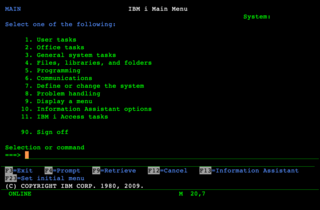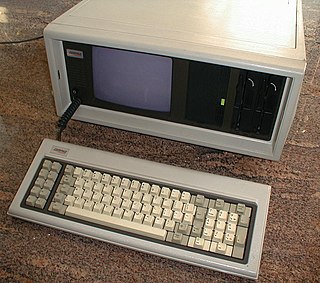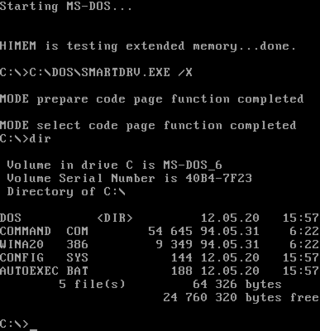
A mainframe computer, informally called a mainframe or big iron, is a computer used primarily by large organizations for critical applications like bulk data processing for tasks such as censuses, industry and consumer statistics, enterprise resource planning, and large-scale transaction processing. A mainframe computer is large but not as large as a supercomputer and has more processing power than some other classes of computers, such as minicomputers, servers, workstations, and personal computers. Most large-scale computer-system architectures were established in the 1960s, but they continue to evolve. Mainframe computers are often used as servers.

A punched card is a piece of card stock that stores digital data using punched holes. Punched cards were once common in data processing and the control of automated machines.

The IBM AS/400 is a family of midrange computers from IBM announced in June 1988 and released in August 1988. It was the successor to the System/36 and System/38 platforms, and ran the OS/400 operating system. Lower-cost but more powerful than its predecessors, the AS/400 was extremely successful at launch, with an estimated 111,000 installed by the end of 1990 and annual revenue reaching $14 billion that year, increasing to 250,000 systems by 1994, and about 500,000 shipped by 1997.
Feng-hsiung Hsu is a Taiwanese-American computer scientist and the author of the book Behind Deep Blue: Building the Computer that Defeated the World Chess Champion. His work led to the creation of the Deep Thought chess computer, which led to the first chess playing computer to defeat grandmasters in tournament play and the first to achieve a certified grandmaster-level rating.

The software release life cycle is the process of developing, testing, and distributing a software product. It typically consists of several stages, such as pre-alpha, alpha, beta, and release candidate, before the final version, or "gold", is released to the public.
The rational unified process (RUP) is an iterative software development process framework created by the Rational Software Corporation, a division of IBM since 2003. RUP is not a single concrete prescriptive process, but rather an adaptable process framework, intended to be tailored by the development organizations and software project teams that will select the elements of the process that are appropriate for their needs. RUP is a specific implementation of the Unified Process.

IBM i is an operating system developed by IBM for IBM Power Systems. It was originally released in 1988 as OS/400, as the sole operating system of the IBM AS/400 line of systems. It was renamed to i5/OS in 2004, before being renamed a second time to IBM i in 2008. It is an evolution of the System/38 CPF operating system, with compatibility layers for System/36 SSP and AIX applications. It inherits a number of distinctive features from the System/38 platform, including the Machine Interface which provides hardware independence, the implementation of object-based addressing on top of a single-level store, and the tight integration of a relational database into the operating system.

A portable computer is a computer designed to be easily moved from one place to another, as opposed to those designed to remain stationary at a single location such as desktops and workstations. These computers usually include a display and keyboard that are directly connected to the main case, all sharing a single power plug together, much like later desktop computers called all-in-ones (AIO) that integrate the system's internal components into the same case as the display. In modern usage, a portable computer usually refers to a very light and compact personal computer such as a laptop, subnotebook or handheld PC, while touchscreen-based handheld ("palmtop") devices such as tablet, phablet and smartphone are called mobile devices instead.
Optical mark recognition (OMR) collects data from people by identifying markings on a paper. OMR enables the hourly processing of hundreds or even thousands of documents. For instance, students may remember completing quizzes or surveys that required them to use a pencil to fill in bubbles on paper. A teacher or teacher's aide would fill out the form, then feed the cards into a system that grades or collects data from them.

IBM Research is the research and development division for IBM, an American multinational information technology company headquartered in Armonk, New York, with operations in over 170 countries. IBM Research is the largest industrial research organization in the world and has twelve labs on six continents.
Everett Franklin Lindquist was a professor of education at the University of Iowa College of Education. He is best known as the creator of the ACT and other standardized tests. His contributions to the field of educational testing are significant and still evident today.
Reynold B. Johnson was an American inventor and computer pioneer. A long-time employee of IBM, Johnson is said to be the "father" of the hard disk drive. Other inventions include automatic test scoring equipment and the videocassette tape.

Electrographic is a term used for punched-card and page-scanning technology that allowed cards or pages marked with a pencil to be processed or converted into punched cards. The primary developer of electrographic systems was IBM, who used mark sense as a trade name for both the forms and processing system. The term has since come to be used generically for any technology allowing marks made using ordinary writing implements to be processed, encompassing both optical mark recognition and electrographic technology.
International Business Machines (IBM) is a multinational corporation specializing in computer technology and information technology consulting. Headquartered in Armonk, New York, the company originated from the amalgamation of various enterprises dedicated to automating routine business transactions, notably pioneering punched card-based data tabulating machines and time clocks. In 1911, these entities were unified under the umbrella of the Computing-Tabulating-Recording Company (CTR).
FlexOS is a discontinued modular real-time multiuser multitasking operating system (RTOS) designed for computer-integrated manufacturing, laboratory, retail and financial markets. Developed by Digital Research's Flexible Automation Business Unit in Monterey, California, in 1985.

DOS is a family of disk-based operating systems for IBM PC compatible computers. The DOS family primarily consists of IBM PC DOS and a rebranded version, Microsoft's MS-DOS, both of which were introduced in 1981. Later compatible systems from other manufacturers include DR-DOS (1988), ROM-DOS (1989), PTS-DOS (1993), and FreeDOS (1998). MS-DOS dominated the IBM PC compatible market between 1981 and 1995.

IBM Watson is a computer system capable of answering questions posed in natural language. It was developed as a part of IBM's DeepQA project by a research team, led by principal investigator David Ferrucci. Watson was named after IBM's founder and first CEO, industrialist Thomas J. Watson.
Linux on IBM Z or Linux on zSystems is the collective term for the Linux operating system compiled to run on IBM mainframes, especially IBM Z / IBM zSystems and IBM LinuxONE servers. Similar terms which imply the same meaning are Linux/390, Linux/390x, etc. The three Linux distributions certified for usage on the IBM Z hardware platform are Red Hat Enterprise Linux, SUSE Linux Enterprise Server, and Ubuntu.

Merative L.P., formerly IBM Watson Health, is an American medical technology company that provides products and services that help clients facilitate medical research, clinical research, real world evidence, and healthcare services, through the use of artificial intelligence, data analytics, cloud computing, and other advanced information technology. Merative is owned by Francisco Partners, an American private equity firm headquartered in San Francisco, California. In 2022, IBM divested and spun-off their Watson Health division into Merative. As of 2023, it remains a standalone company headquartered in Ann Arbor with innovation centers in Hyderabad, Bengaluru, and Chennai.

IBM designed, manufactured and sold optical mark and character readers from 1960 until 1984. The IBM 1287 is notable as being the first commercially sold scanner capable of reading handwritten numbers.












